Control and Managing of Individual Solar Water Heating Systems in an Apartment Complex
Abstract
1. Introduction
2. Methods
2.1. The Design and Functionality of a Conventional Water Heating System
2.2. The Improved Individual Solar Heating Appliances
2.3. Control System Algorithm and Electronic Implementation
3. Results
3.1. The Exactness of a Tank Hot Water Temperature Estimation
3.2. Statistic Data of the Solar Heating Operation with a Control Unit
4. Discussion and Conclusions
Author Contributions
Funding
Data Availability Statement
Conflicts of Interest
References
- Thirugnanasambandam, M.; Iniyan, S.; Goic, R. A review of solar thermal technologies. Renew. Sustain. Energy Rev. 2010, 14, 312–322. [Google Scholar] [CrossRef]
- Ibrahim, O.; Fardoun, F.; Younes, R.; Louahlia-Gualous, H. Review of water-heating systems: General selection approach based on energy and environmental aspects. Build. Environ. 2014, 72, 259–286. [Google Scholar] [CrossRef]
- Streicher, W. Solar thermal technologies for domestic hot water preparation and space heating. In Renewable Heating and Cooling; Elsevier: Amsterdam, The Netherlands, 2016; pp. 9–39. [Google Scholar]
- Al-Mamun, M.R.; Roy, H.; Islam, M.S.; Ali, M.R.; Hossain, M.I.; Aly, M.A.S.; Khan, M.Z.H.; Marwani, H.M.; Islam, A.; Haque, E. State-of-the-art in solar water heating (SWH) systems for sustainable solar energy utilization: A comprehensive review. Sol. Energy 2023, 264, 111998. [Google Scholar] [CrossRef]
- Wang, Z.; Yang, W.; Qiu, F.; Zhang, X.; Zhao, X. Solar water heating: From theory, application, marketing and research. Renew. Sustain. Energy Rev. 2015, 41, 68–84. [Google Scholar] [CrossRef]
- Huang, D.; Ma, H.; Ma, S.; Chen, M.; Xu, C.; Zhang, Y.; Yan, C. Study on the Energy Efficiency Improvement and Operation Optimization of a Solar Water Heating System. Appl. Sci. 2022, 12, 7263. [Google Scholar] [CrossRef]
- Artur, C.; Neves, D.; Cuamba, B.C.; Leão, A.J. Domestic hot water technology transition for solar thermal systems: An assessment for the urban areas of Maputo city, Mozambique. J. Clean. Prod. 2020, 260, 121043. [Google Scholar] [CrossRef]
- Coelho, L.; Koukou, M.K.; Konstantaras, J.; Vrachopoulos, M.G.; Rebola, A.; Benou, A.; Karytsas, C.; Tourou, P.; Sourkounis, C.; Gaich, H. Assessing the Effectiveness of an Innovative Thermal Energy Storage System Installed in a Building in a Moderate Continental Climatic Zone. Energies 2024, 17, 763. [Google Scholar] [CrossRef]
- Martinopoulos, G.; Papakostas, K.T.; Papadopoulos, A.M. Comparative analysis of various heating systems for residential buildings in Mediterranean climate. Energy Build. 2016, 124, 79–87. [Google Scholar] [CrossRef]
- Umer, M.; Dilshad, S.; Akbar, A.; Abas, N. Simulation Analysis of Solar Thermal Water Heating System for Climate of Lahore. In Proceedings of the 2022 International Conference on Emerging Trends in Electrical, Control, and Telecommunication Engineering (ETECTE), Lahore, Pakistan, 2–4 December 2022; IEEE: Piscataway, NJ, USA, 2022; pp. 1–6. [Google Scholar]
- Hernandez Uribe, O.; San Martin, J.P.; Garcia-Alegre, M.C.; Santos, M.; Guinea, D. Smart building: Decision making architecture for thermal energy management. Sensors 2015, 15, 27543–27568. [Google Scholar] [CrossRef] [PubMed]
- Standard ISO 9459-5:2007. Available online: www.iso.org/standard/39820.html (accessed on 1 March 2024).
- Yoo, M. Optimal Design and Parameter Estimation for Small Solar Heating and Cooling Systems. Sustainability 2023, 15, 16352. [Google Scholar] [CrossRef]
- Lillo-Bravo, I.; Vera-Medina, J.; Fernandez-Peruchena, C.; Perez-Aparicio, E.; Lopez-Alvarez, J.A.; Delgado-Sanchez, J.M. Random Forest model to predict solar water heating system performance. Renew. Energy 2023, 216, 119086. [Google Scholar] [CrossRef]
- Azzouzi, M. Control of solar water heater design. In Proceedings of the 2011 10th International Conference on Environment and Electrical Engineering, Rome, Italy, 8–11 May 2011; IEEE: Piscataway, NJ, USA, 2011; pp. 1–5. [Google Scholar]
- Dbouk, H.M.; Ali, R.A.; Ghamlouch, M.; Elhajj, I.H. Temperature Control for Residential Solar Water Heating Systems. In Proceedings of the IEEE EUROCON 2019—18th International Conference on Smart Technologies, Novi Sad, Serbia, 1–4 July 2019; IEEE: Piscataway, NJ, USA, 2019; pp. 1–6. [Google Scholar]
- Cui, X.; Kou, Z.; Qiao, Y. Water-level Control System for Solar Water Heating Engineering based on PLC. In Proceedings of the 2019 IEEE 3rd Information Technology, Networking, Electronic and Automation Control Conference (ITNEC), Chengdu, China, 15–17 March 2019; IEEE: Piscataway, NJ, USA, 2019; pp. 1625–1628. [Google Scholar]
- Muñiz, R.; del Coso, R.; Nuño, F.; Villegas, P.J.; Álvarez, D.; Martínez, J.A. Solar-Powered Smart Buildings: Integrated Energy Management Solution for IoT-Enabled Sustainability. Electronics 2024, 13, 317. [Google Scholar] [CrossRef]
- Shi, F.; Kou, Z.; Li, W.; Chen, J. Design and Application of Water-temperature Measurement and Control System for Solar Water-heating Engineering Device. In Proceedings of the 2020 IEEE 4th Information Technology, Networking, Electronic and Automation Control Conference (ITNEC), Chongqing, China, 12–14 June 2020; IEEE: Piscataway, NJ, USA, 2020; pp. 1741–1745. [Google Scholar]
- Halam, R.; Raman, R. Enhancing Energy Efficiency in Solar Water Heating Systems for Sustainable Homes with IoT Technology. In Proceedings of the 2023 International Conference on Innovative Computing, Intelligent Communication and Smart Electrical Systems (ICSES), Chennai, India, 14–15 December 2023; IEEE: Piscataway, NJ, USA, 2023; pp. 1–6. [Google Scholar]
- Znaczko, P.; Kaminski, K.; Chamier-Gliszczynski, N.; Szczepanski, E.; Gołda, P. Experimental analysis of control methods in solar water heating systems. Energies 2021, 14, 8258. [Google Scholar] [CrossRef]
- Zhou, C.; Liang, R.B.; Zhang, J.L. Optimization design method and experimental validation of a Solar PVT cogeneration system based on building energy demand. Energies 2017, 10, 1281. [Google Scholar] [CrossRef]
- Li, W.; Thirugnanam, K.; Tushar, W.; Yuen, C.; Chew, K.T.; Tai, S. Improving the operation of solar water heating systems in green buildings via optimized control strategies. IEEE Trans. Ind. Inform. 2018, 14, 1646–1655. [Google Scholar] [CrossRef]
- Zhao, Z.; Wang, C.; Wang, B. Adaptive model predictive control of a heat pump-assisted solar water heating system. Energy Build. 2023, 300, 113682. [Google Scholar] [CrossRef]
- Liao, Z.; Dexter, A.L. An inferential model-based predictive control scheme for optimizing the operation of boilers in building space-heating systems. IEEE Trans. Control Syst. Technol. 2009, 18, 1092–1102. [Google Scholar] [CrossRef]
- Jamaaoui, F.; Puig, V.; Ayadi, M. Optimal Control of Hybrid Photovoltaic/Thermal Water System in Solar Panels Using the Linear Parameter Varying Approach. Processes 2023, 11, 3426. [Google Scholar] [CrossRef]
- Azzouzi, M.; Attia, B.; Hourier, B.; Messaoudi, M. Realization of solar water heating controlling board. In Proceedings of the 2011 International Conference on Multimedia Computing and Systems, Ouarzazate, Morocco, 7–9 April 2011; IEEE: Piscataway, NJ, USA, 2011; pp. 1–4. [Google Scholar]
- Salamone, F.; Belussi, L.; Danza, L.; Ghellere, M.; Meroni, I. An open-source low-cost wireless control system for a forced circulation solar plant. Sensors 2015, 15, 27990–28004. [Google Scholar] [CrossRef] [PubMed]
- Mini Motorized Valve. Available online: https://www.motorisevanne.com/product-category/mini-motorized-valve/cwx-15n/ (accessed on 12 April 2024).
- Temperature Sensors. Available online: https://www.digipart.com/part/DS18B20?msclkid=10cd41f7998717c1aae027b5e042b141&utm_source=bing&utm_medium=cpc&utm_campaign=Tier_Popar&utm_term=DS18B20&utm_content=Tier_Popular_0 (accessed on 12 April 2024).
- Water Flow Measurement Sensor YF-S201. Available online: https://components101.com/sensors/yf-s201-water-flow-measurement-sensor (accessed on 11 March 2024).
- Wi-Fi Module. Available online: https://microcontrollerslab.com/esp8266-getting-started-tutorial/ (accessed on 29 April 2024).
- Current Sensor. Available online: http://en.yhdc.com/comp/file/download.do?id=943 (accessed on 20 April 2024).
- Li-Ion Battery Charger. Available online: https://www.monolithicpower.com/en/mp2615.html (accessed on 20 April 2024).
- Two Cell Li-Ion Battery. Available online: https://www.feyelektronik.de/downloads/db-pa-iec-lnb76.pdf (accessed on 20 April 2024).
- Current Monitor. Available online: https://www.ti.com/product/INA381/part-details/INA381A1IDGSR (accessed on 20 April 2024).
- OLED Display 128x64. Available online: https://www.diymore.cc/products/2-42-inch-12864-oled-display-module-iic-i2c-spi-serial-for-arduino-c51-stm32-green-white-blue-yellow?_pos=6&_sid=f4f532b3b&_ss=r (accessed on 20 April 2024).
- MATLAB Colomap. Available online: https://www.mathworks.com/help/matlab/ref/colormap.html (accessed on 9 February 2024).
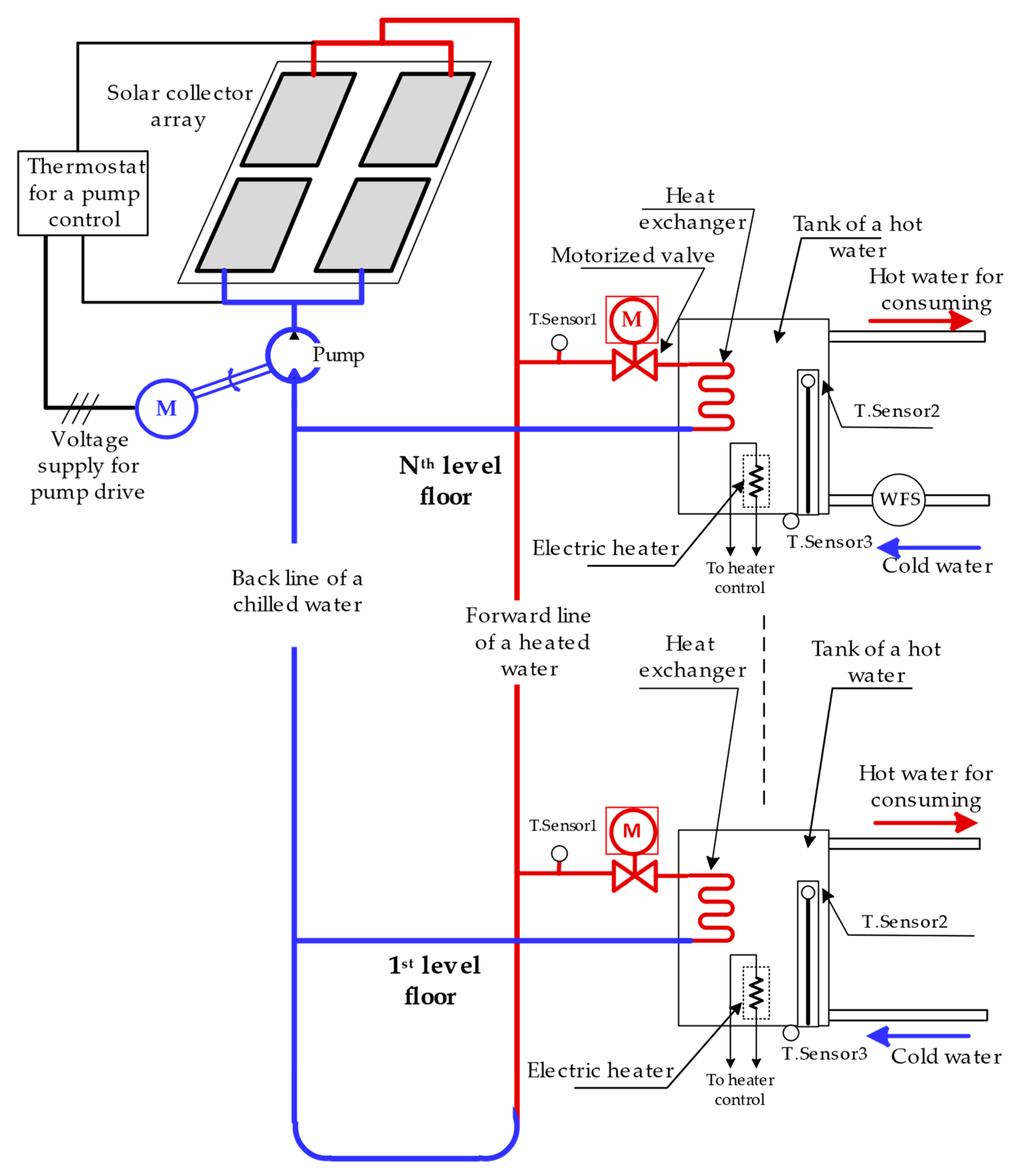
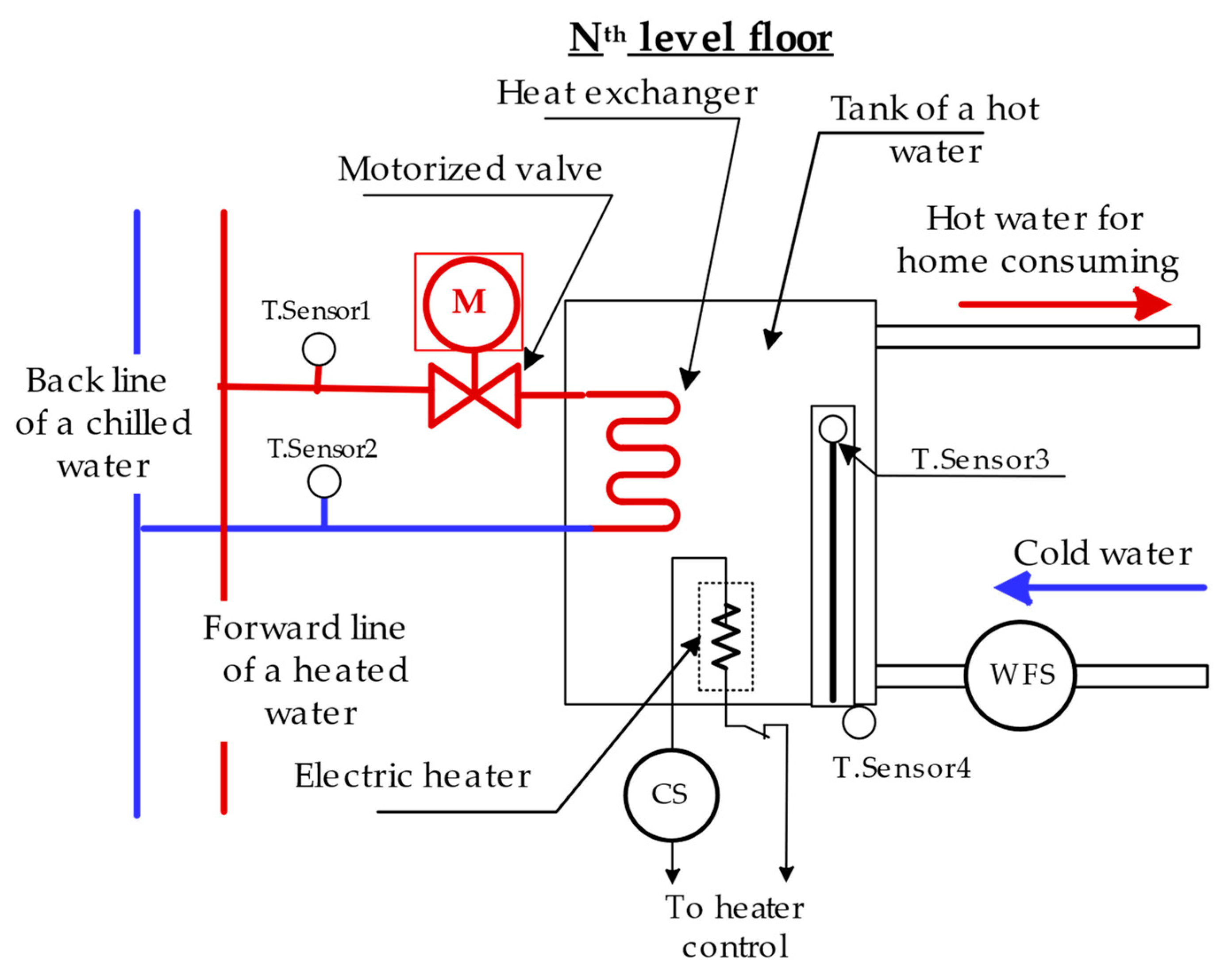
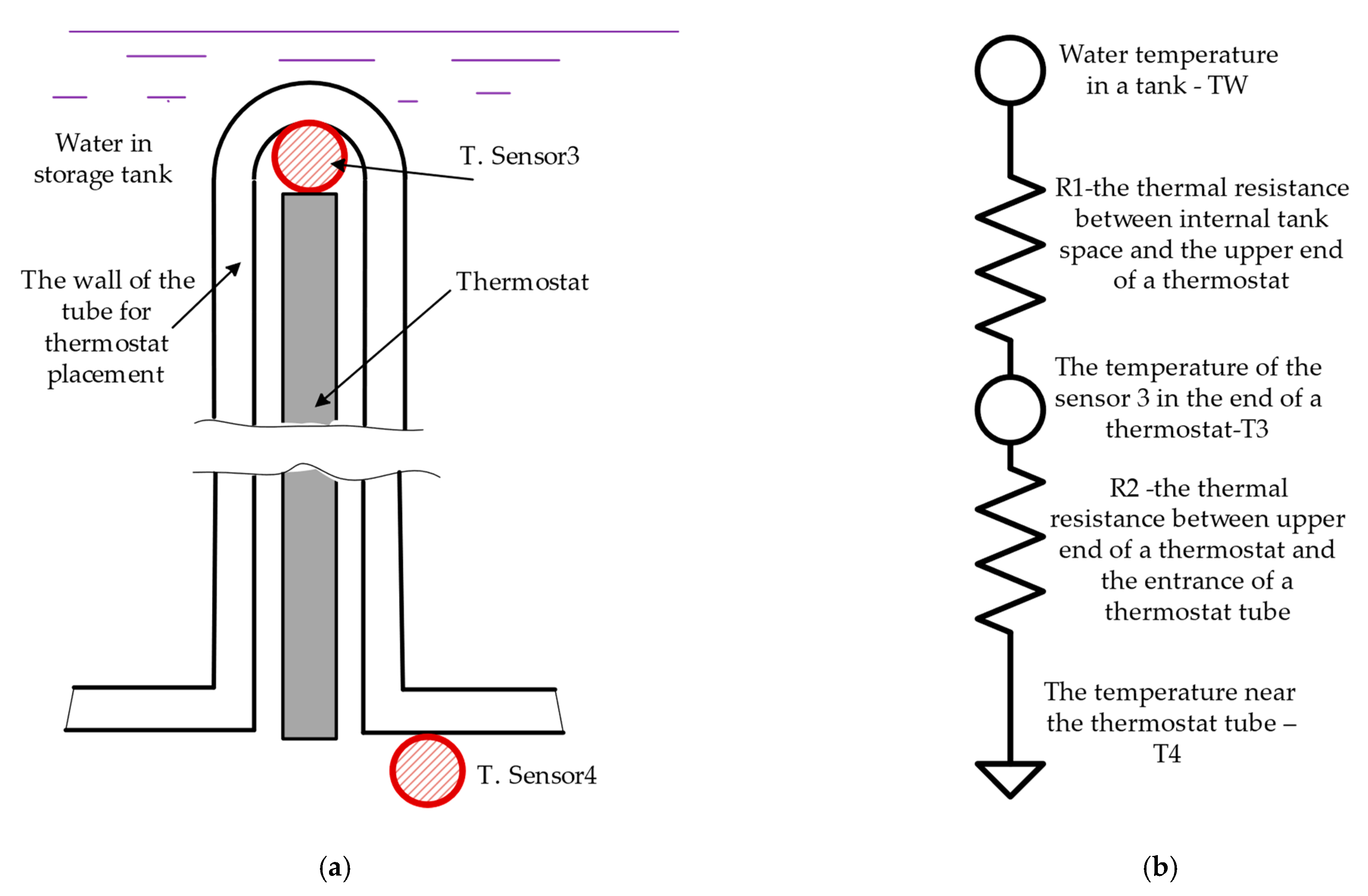

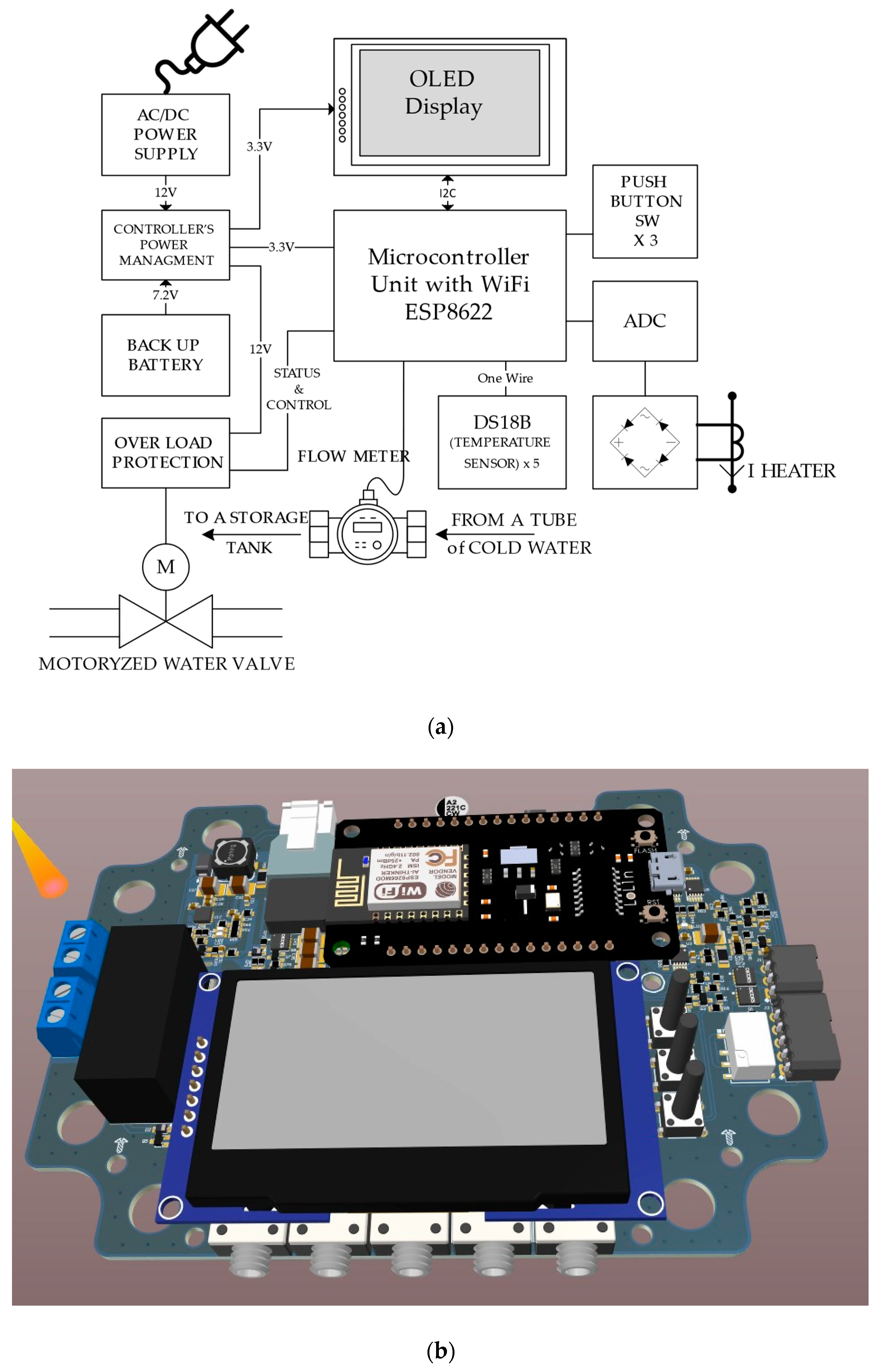
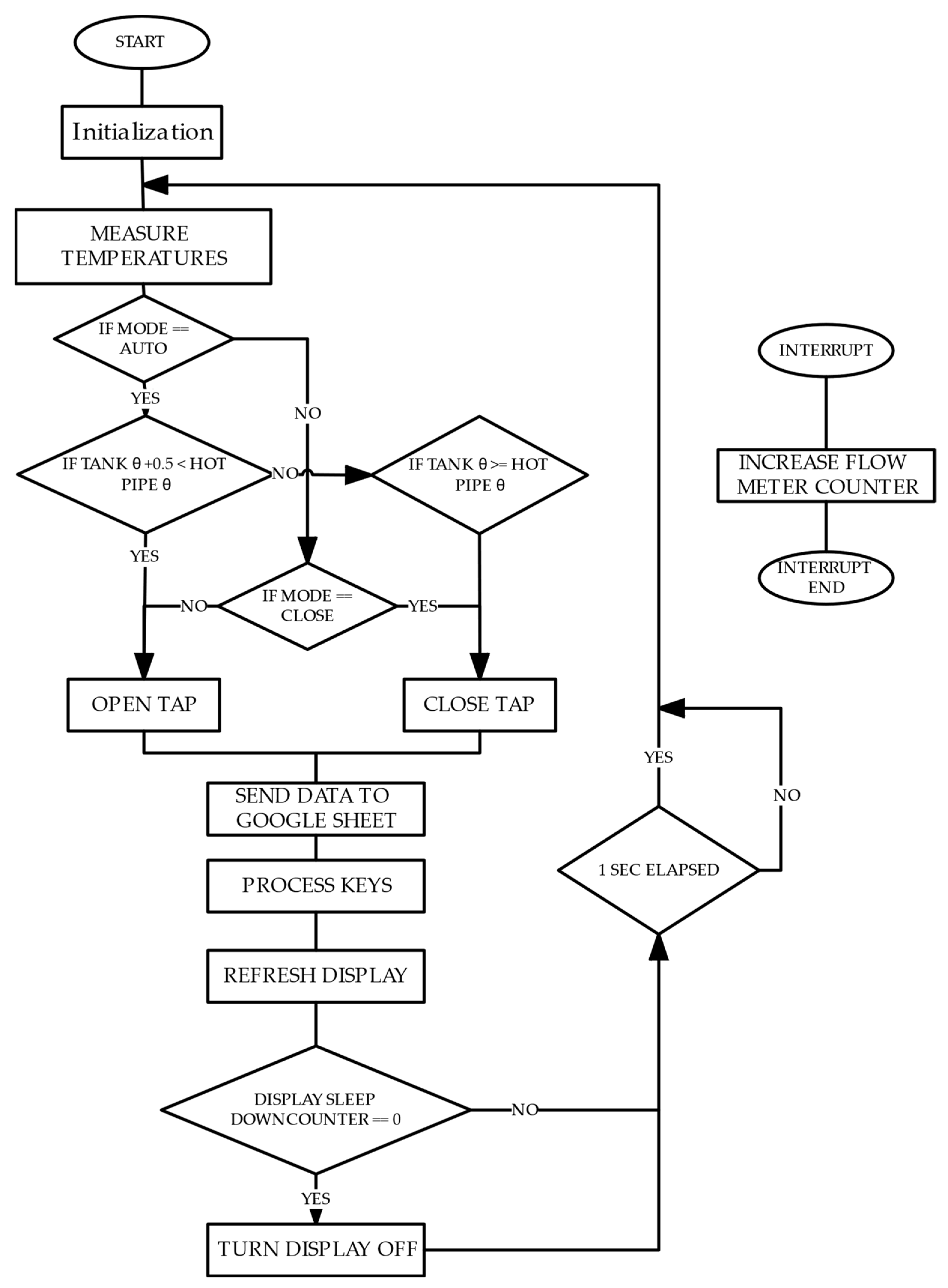
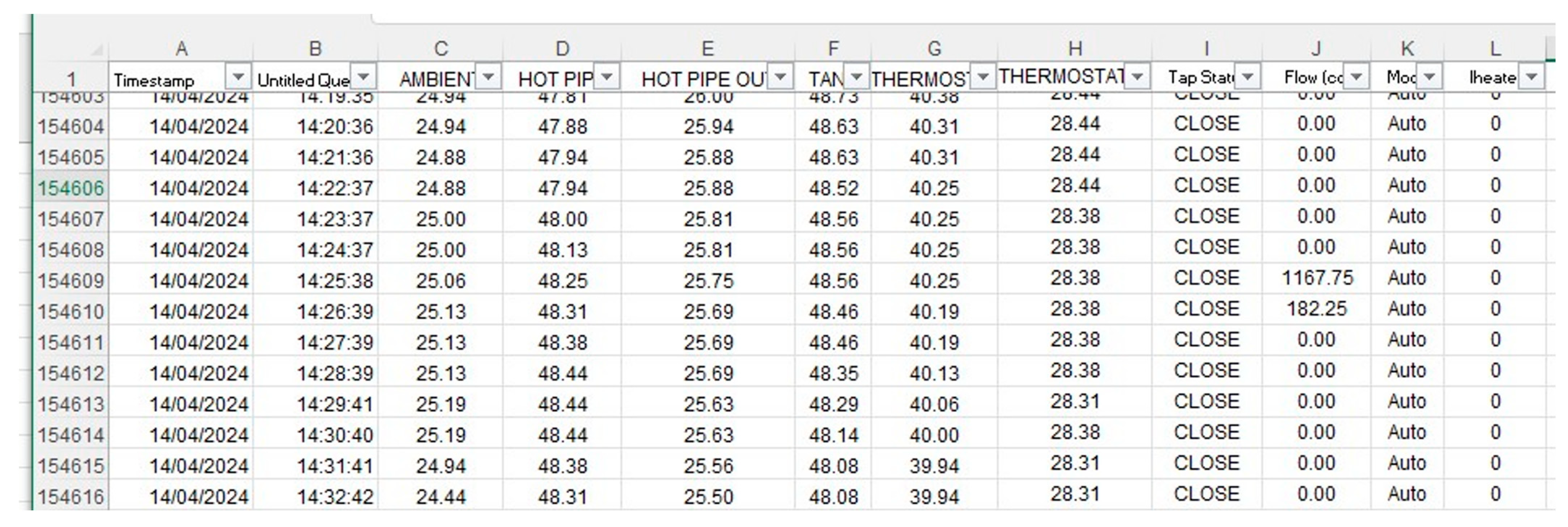


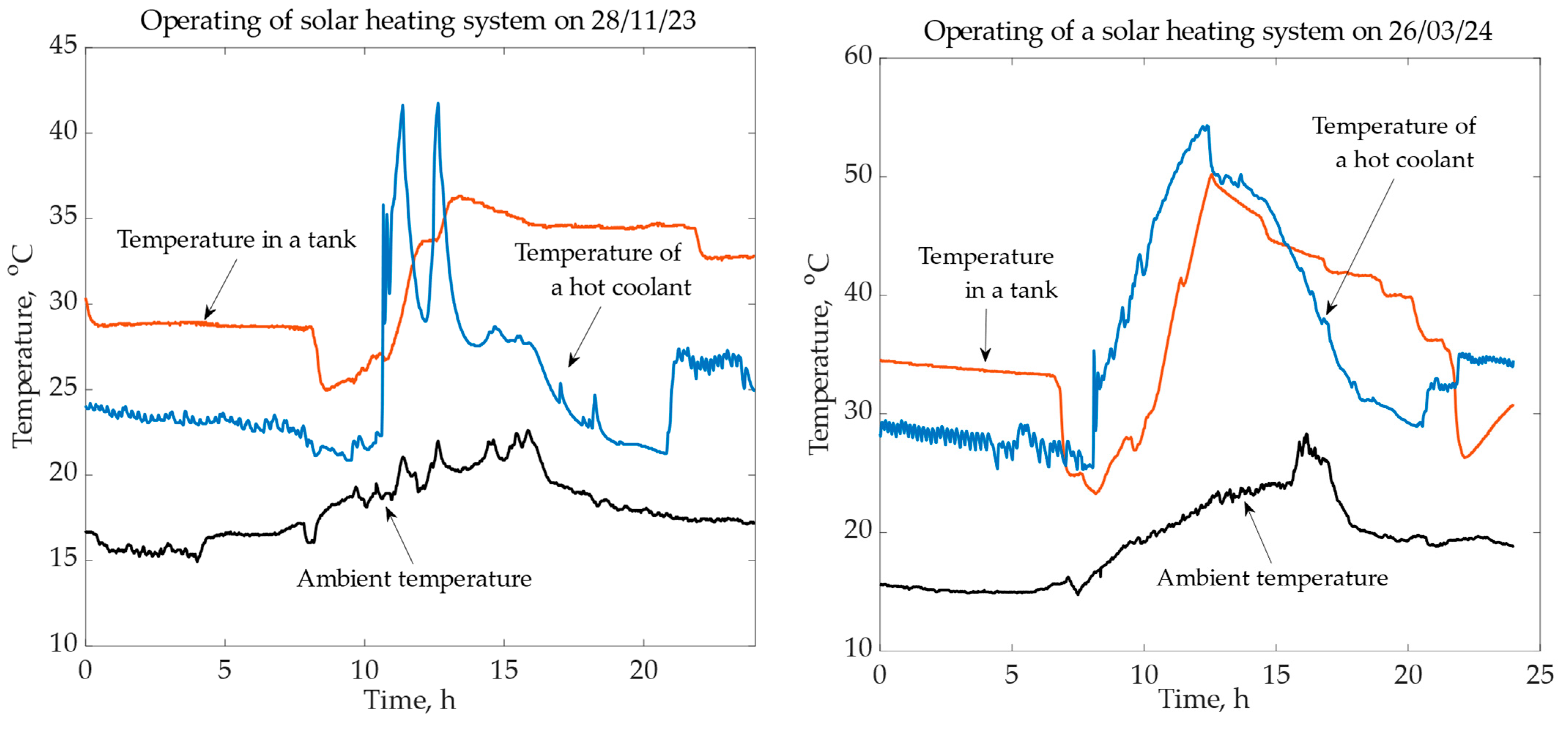
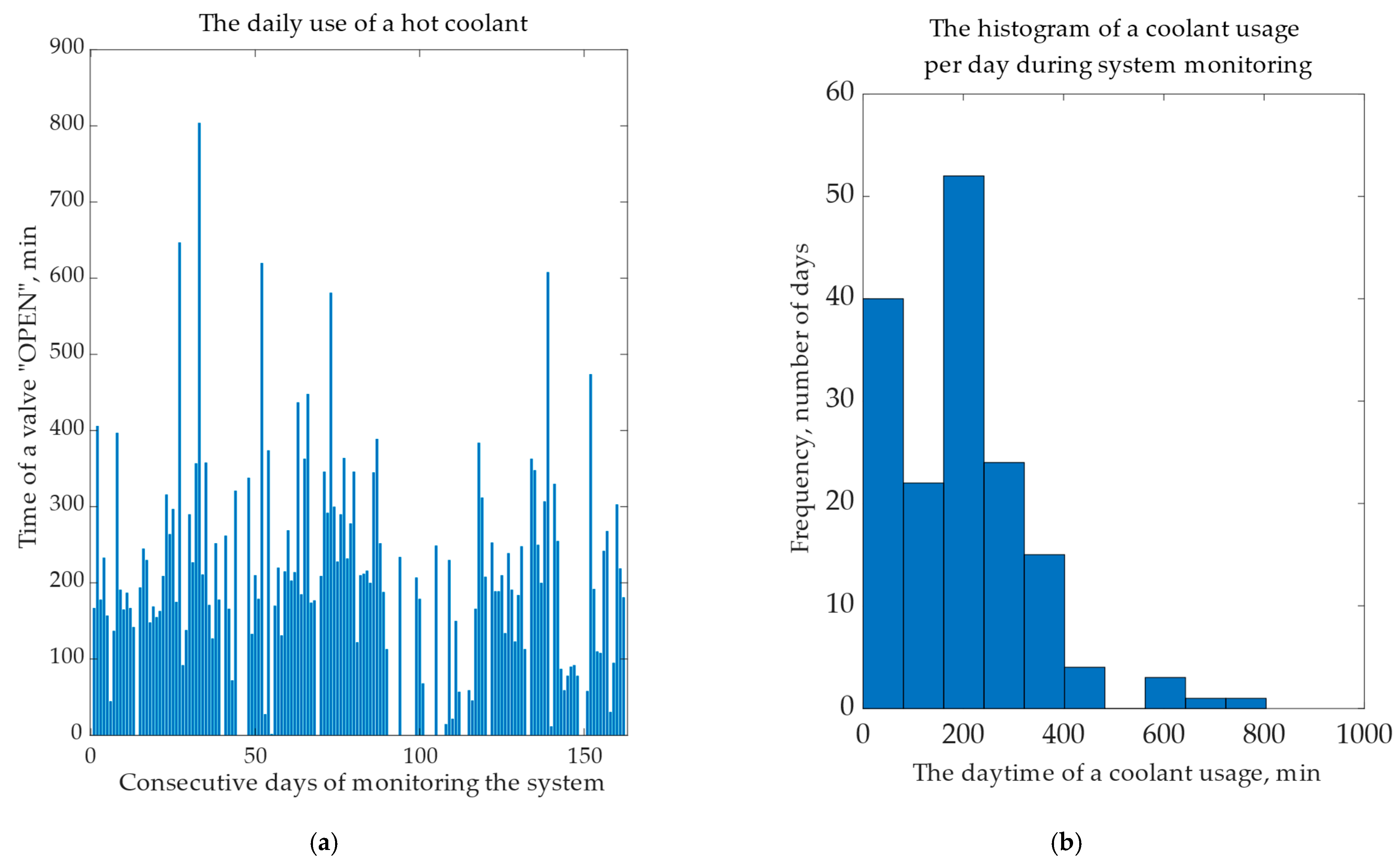

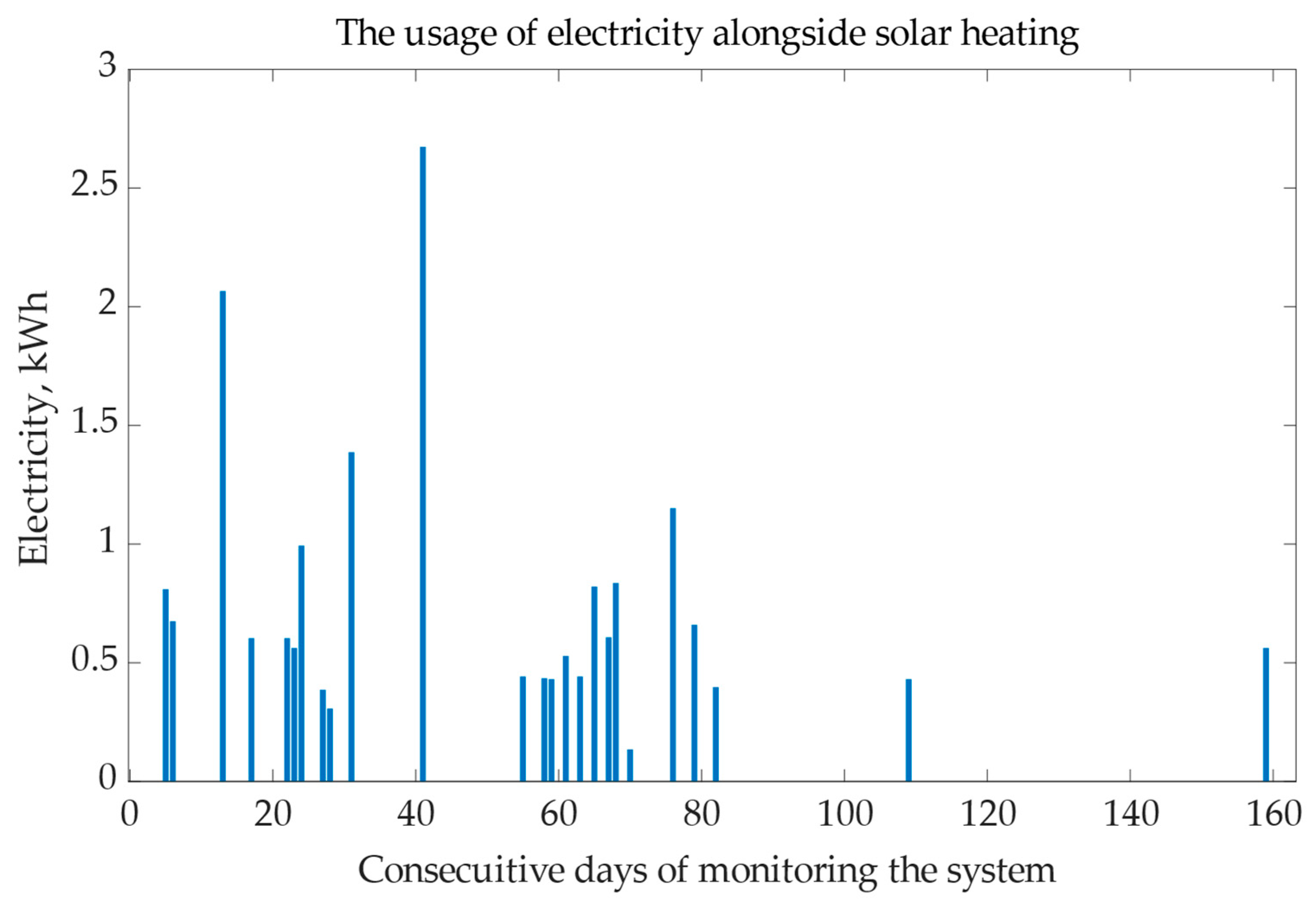
Disclaimer/Publisher’s Note: The statements, opinions and data contained in all publications are solely those of the individual author(s) and contributor(s) and not of MDPI and/or the editor(s). MDPI and/or the editor(s) disclaim responsibility for any injury to people or property resulting from any ideas, methods, instructions or products referred to in the content. |
© 2024 by the authors. Licensee MDPI, Basel, Switzerland. This article is an open access article distributed under the terms and conditions of the Creative Commons Attribution (CC BY) license (https://creativecommons.org/licenses/by/4.0/).
Share and Cite
Krinitsky, M.; Averbukh, M. Control and Managing of Individual Solar Water Heating Systems in an Apartment Complex. Electronics 2024, 13, 2305. https://doi.org/10.3390/electronics13122305
Krinitsky M, Averbukh M. Control and Managing of Individual Solar Water Heating Systems in an Apartment Complex. Electronics. 2024; 13(12):2305. https://doi.org/10.3390/electronics13122305
Chicago/Turabian StyleKrinitsky, Michael, and Moshe Averbukh. 2024. "Control and Managing of Individual Solar Water Heating Systems in an Apartment Complex" Electronics 13, no. 12: 2305. https://doi.org/10.3390/electronics13122305
APA StyleKrinitsky, M., & Averbukh, M. (2024). Control and Managing of Individual Solar Water Heating Systems in an Apartment Complex. Electronics, 13(12), 2305. https://doi.org/10.3390/electronics13122305






